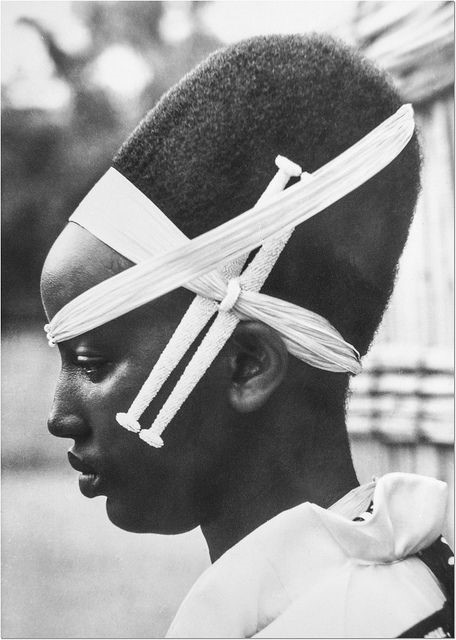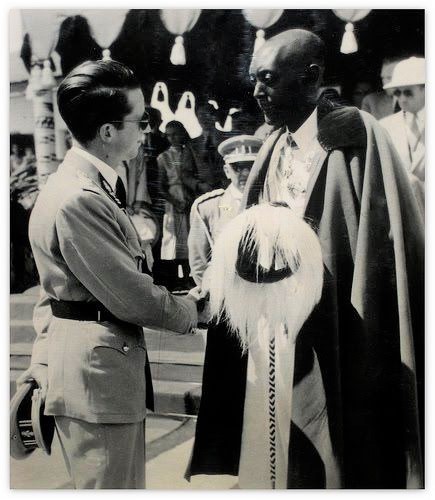Queen Gicanda was the wife of Rwandan Mwami (King in the Kinyarwanda language) Mutara III of Rwanda. After her husband died in mysterious circumstances in 1959, the Rwandan monarchy lasted only two more years, under the leadership of Mwami Kigeli V of Rwanda and then coming to an end in 1961.
This Queen looks similar to Princess Emma Bakayishonga.

They closely resemble each other so much that it’s hard for some to distinguish the two.
What’s quite curious about these people they also worshiped the bull like the ancient Egyptians and in the Southern part of India where it’s considered sacred as well.


To distinct the difference between Princess Emma Bakayishonga & this Queen Dowager Rosalie Gicanda, is that Queen Gicanda has slightly a fuller face & much larger lips.

Natural & Beautiful Elongated Skulls of Africans and African descendants found in 2016?
–orwelltoday.com/readerrwandaqueen


However, the Queen continued to live in Butare in Butare Province, Rwanda.

On 20 April 1994, as the Rwandan Genocide began in earnest in Butare, a detachment of soldiers commanded by Lt. Pierre Bizimana, acting under the orders of Capt. Idelphonse Nizeyimana, kidnapped the former Queen along with others from her house. They then took the captives behind the National Museum and shot them. Only a younger girl survived to tell the story of the murders. Two days later, the Queen’s mother was also murdered. At the request of a priest, Butare mayor Kanyabashi recovered Queen Gicanda’s body and had it buried in the yard next to her house. She was about 80 years old.
The Queen was a living symbol for Tutsis, and her murder shocked many. It effectively signaled the beginning of the mass killing in the Butare area, which saw some of the worst atrocities committed during the fighting.
After the genocide, a Rwandan military court found Bizimana and Private 1st Class Aloys Mazimpaka guilty of genocide and the murder of Queen Gicanda and her family. (Chambre Specialisée du Conseil de Guerre de Butare, case no. LMD 187, LP 0001-PS 97, Judgment pronounced July 27, 1998.) Bizimana was sentenced to death, Mazimpaka to life in prison.
On 6 October 2009, former intelligence chief Idelphonse Nizeyimana was arrested in Kampala, Uganda. Nizeyimana was one of the most wanted suspects in the Rwandan genocide. On 19 June 2012, he was convicted by the International Criminal Tribunal for Rwanda of ordering the killing of the former Tutsi queen, as well as other murders, and was sentenced to life imprisonment.

One of the surviving female royals conducting an interview with Rwanda TV (RTV) News is broadcasted on Rwanda TV daily.
Kinyarwanda also known as Rwanda (Ruanda) or Rwandan, or in Uganda as Fumbira, is the official language of Rwanda and a dialect of the Rwanda-Rundi language spoken by 12 million people in Burundi and adjacent parts of southern Uganda. (The Kirundi dialect is the official language of neighboring Burundi.)
Kinyarwanda is one of the three official languages of Rwanda (along with English and French), and is spoken by almost all of the native population. This contrasts with most modern African states, whose borders were drawn by colonial powers and did not correspond to ethnic boundaries or pre-colonial kingdoms.
I can’t find anything in English or the other major languages to translate this interview. Since this is an older video, it does not offer closed caption (CC) as an option. – Sola
RBA – Rwanda Broadcasting Agency
Queen Dowager Rosalie Gicanda husband the King Mutara III

Also I would like to note that this royal family in particular are extremely tall.

1949: Visite Mutara III en Belgique

–sciencespolitiquesrwandaises.fr

King mutara with the white missionaries above.
He mediated between the Belgian colonialists and the Catholic Church.

Theory or fact of the King’s death.
Although many recognized the growing severity of the rift that had developed between the Mwami, resolutely dedicated to furthering the welfare of his people under the sacred banner of Christ the King, and the Belgians, eager to retain their hold on the physical resources of the nation, few could have foreseen the extent and consequences of the drama that was to be played out in July of 1959. On Friday, July 24, 1959, King Mutara traveled to Usumbura, from whence he planned eventually to journey to New York to put the case for Rwandan independence before the United Nations. The day after his arrival there, the mwami requested a shot of penicillin from Dr. Vinck, a Belgian stand-in for his his personal physician, whom he had seen earlier in the day. The doctor administered a dose of about 1 million units of megacillin, and during the course of a brief conversation with Vinck
following the shot, the King collapsed and died, apparently struck down by a massive cerebral hemorrhage.
Read more:
The Nyabarongo (or Nyawarungu) is a major river in Rwanda, part of the upper headwaters of the Nile. The river begins in Nyungwe Forest, at a location considered by some to be the most distant source of the Nile. From this source it follows a course up to the north-western part of the country, then down through the centre to the south-east, eventually forming the main tributary of the Kagera River, which flows into Lake Victoria.

–amateka-n-umuco/article/sobanukirwa-amateka-ya-mutara-iii-rudahigwa-nkubito-y-imanzi
Natural & Beautiful Elongated Skulls of Africans and African descendants found in 2016?






[…] Queen Dowager Rosalie Gicanda […]